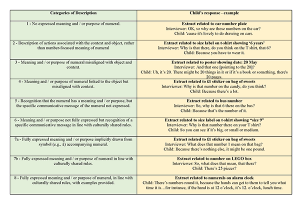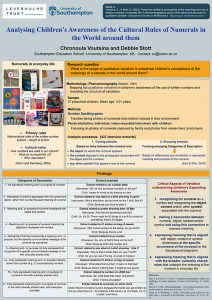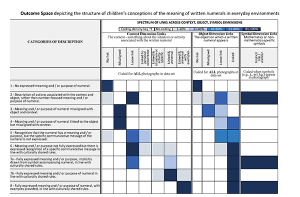
A longitudinal study to explore pre-school children’s understanding of the cultural rules and meanings of written numerals in their everyday environments.
February 2021 – March 2023

Part 1
We examined preschool children’s conceptions of the multiple meanings and social uses of numerals in everyday life.
We invited families to play a Number Spotting Game over five days, prompting children to notice written numerals in their everyday environment. Parents were asked to take pictures of the written numbers that children noticed using their mobile phones and send them to the researchers.
We used these photographs of numerals, together with other photographs of written numbers that we had sourced, in a photo-elicitation interview with each child.
We adopted elements of Phenomenography (Marton, 1981) to analyse the data.
Key Findings
Categories of Description that offer a comprehensive qualitative map of the full range of preschool children’s conceptions of the cultural rules of numerals in everyday life.
Four Critical Aspects of Variation in children’s awareness. The Critical Aspects of Variation that define the distinction between the categories of description and children’s responses are:
a) Whether the child recognises the written numeral as a number and recognises and is aware of the object, context and/or accompanying symbol associated with the numeral.
b) Whether the child makes a connection between the written numeral, object, context and/or symbol and uses this connection to deduce or express meaning and purpose.
c) Whether the expressed meaning and connections that children make are aligned with the object, context or symbol dimensions at the specific occurrence of the written numeral (in the photograph under discussion).
d) Whether the expressed meaning and connections that children make are aligned with the broader, culturally shared rules that underpin the meaning and purpose of the written numeral in everyday life.
These critical aspects are significant as they indicate the key dimensions of awareness that need to be supported by interactions with adults and early mathematics pedagogy, in order to help children expand their awareness of the meanings and purposes of written numerals in everyday environments and beyond the context of arithmetic.
(click to view pdf)
The Outcome Space: a diagram revealing that the structure that underpins the variation in children’s conceptions is informed by the nature and strength of links that children make between their awareness of a numeral, their awareness of the context and object on which the numeral appears, as well as the links that they make between the number and other symbols (e.g., £) accompanying the numeral.
(click to view pdf)
Related Publications
Voutsina, C., & Stott, D. (2023). Preschool children’s conceptions of the meanings and use of written numerals in everyday life: A phenomenographic study of the nature and structure of qualitative variation. Educational Studies in Mathematics. https://doi.org/10.1007/s10649-023-10232-1
Voutsina, C., & Stott, D. (2023). Analysing children’s awareness of the cultural rules of numerals in the world around them. Poster presentation at the 13th Congress of European Society for Research in Mathematics Education (CERME-13). Budapest, Hungary, 10-14 July 2023.
Funded by
Feedback to the team






